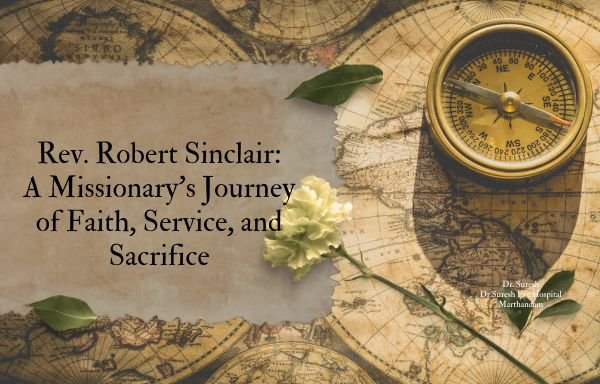Rev. Robert Sinclair’s life was marked by deep faith, dedication, and sacrifice. A missionary with the London Missionary Society, he spent over 30 years in Martandam, South India, where he built churches, schools, and fostered strong connections between Scotland and India. His work culminated in the construction of the Martandam Church, symbolizing his commitment to service. In 1980, his son, Dr. John R. Sinclair, laid the foundation stone of the Sinclair Hall, honoring his father’s legacy. Dr. Robert Sinclair’s unwavering devotion to faith and community continues to inspire, reminding us that the true Church is its people, not just buildings.
Rev. Robert Sinclair:
A Missionary’s Journey of Faith, Service, and Sacrifice
In one of Dr. John Sinclairs letters, Dr. John Sinclair mentions about her father Rev. Rober Sinclair.
His father Rev. Robert Sinclair, was born in Cambuslang, near Glasgow, on November 15, 1883. His father, John Sinclair, was a stonemason who passed away at an early age, leaving Robert to care for his mother, sister, and brother. After leaving school at fourteen, Robert worked as a blacksmith until he was seventeen. By then, he had become deeply involved in the Congregational Church in Cambuslang. He studied at the Bible Training Institute in Glasgow for two years before enrolling at Nottingham College to train for the ministry, from which he graduated. To save money, he cycled each term to Nottingham, which was approximately 375 miles from his hometown.
In 1909, Robert joined the London Missionary Society and was sent to Nagercoil. A year later, he was joined by his bride, Miss Elizabeth Smith from Kirkhil, near Cambuslang. They were married in 1910 by Rev. Mr. Parker. It took great courage for Elizabeth to travel so far in those days, especially as her parents were very concerned for her safety. Yet, as they say in Scotland, "love will find a way."
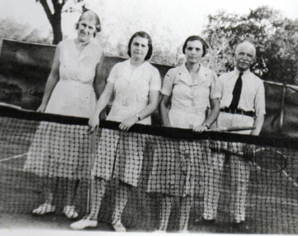
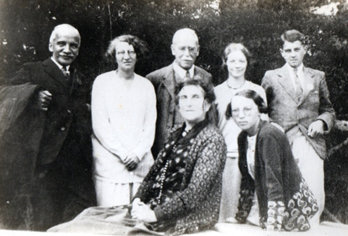
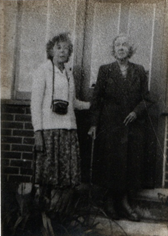

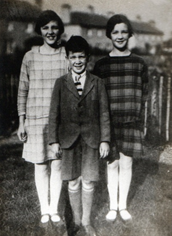
A few years later, Robert was transferred to Martandam, where his main life’s work began. During this time, churches and schools were built, and the Christian population grew significantly. It soon became clear that a large, permanent church was needed. Architects in Glasgow drew up plans, and construction began around 1923. Progress was slow, and one of his earliest memories as a child in Martandam was watching men maneuver stones into position using pulleys attached to crossbars over two parallel palmyra trunks. Later, a builder from Cambuslang donated a crane, which helped speed up the work.
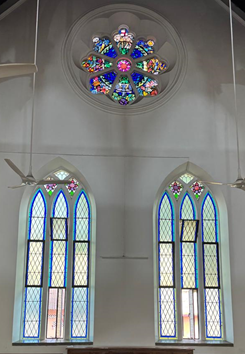
The stained glass windows for the church were made in Glasgow, and he remembers being taken to see them before they were shipped to India. It was a joyful moment for him when he and his wife visited Martandam in 1980 and 1981 and saw the windows in place.
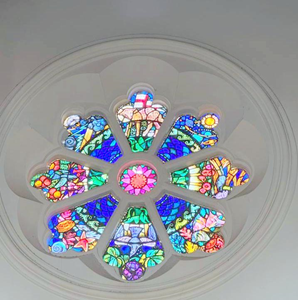
These windows were a memorial to his father's sister, Jessie Rose, and were gifted by her husband in her memory. The church bell, cast in a Glasgow foundry, was an exact replica of the bell from the Old Parish Church in Kirkhil. Each Sunday, when his parents heard the bell ring in Martandam, they were reminded of their home in Scotland.
The Cambuslang congregation continued to support the church and its institutions. One of Robert’s gifts to the church was the organ, and the beautiful embroidery created by the congregation helped raise funds for the installation of a three-faced tower clock in the bell tower.

Before the church opened in 1933, Robert arranged for Communion services to be held simultaneously in both Martandam and Cambuslang, with identical bells calling the faithful to worship in both places—one in South India and the other in Scotland.
During this time, his mother worked tirelessly in the embroidery industry, teaching handcrafts and needlework to hundreds of girls and women, and supported Robert in all his work.
In 1926, at the age of seven, he and his two sisters, Sybil and Isabel, were sent to Glasgow for their education, as it was the custom for missionaries to return home for furlough every seven years. Though their aunt cared for them in a Christian home, he vividly remembered how much they missed their parents. The sacrifice his parents made in being separated from their children during their formative years was great, but it was made willingly in the service of their faith. They wrote to their children every week, and in return, the children wrote letters to them, though replies took about seven weeks due to the long delays in mail delivery.
When Robert and Elizabeth returned to Scotland on furlough in 1939, their plans to return to India were thwarted by the outbreak of World War II. Robert was deeply distressed at not being able to return to Martandam, where he felt there was still much work to be done. Instead, he accepted a call to Morriston Church in Clydebank, where he worked with great energy, especially during and after the terrible bombing of the area in 1942. The strain of this work took a toll on his health, and he passed away suddenly on September 12, 1946, after dedicating 47 years to the Church, 30 of which were spent in India, working among the people he loved dearly.
While Martandam Church will always be associated with his father’s name, it is important to remember his enduring commitment to health, education, physical fitness, and the dignity of every individual. On a personal note, he reminds everyone that while the church building in Martandam is important, the true Church is not just a structure. It is the people, and each individual must bear witness to their faith both within their community and in the wider world. 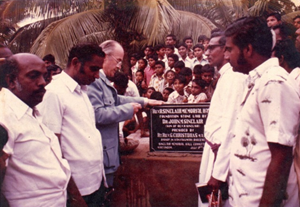
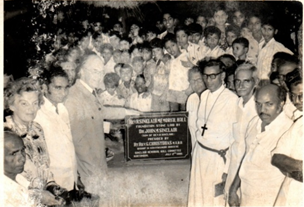
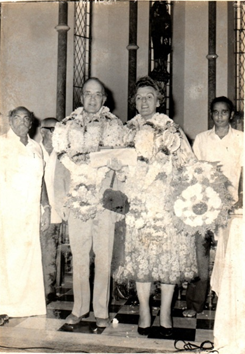
Dr. John R. Sinclair, the son of Robert Sinclair, along with his wife Dr. Margaret Sinclair, laid the foundation stone of the memorial hall during their first visit . This deeply symbolic act marked a significant moment, as it was fitting for the son to lay the foundation for his father's memorial hall, honoring his father's enduring legacy in the country.
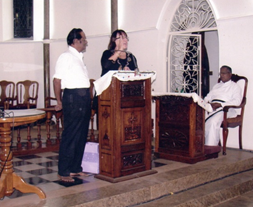
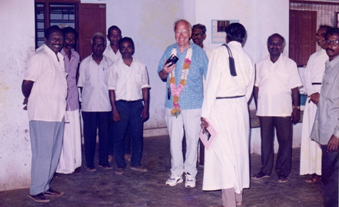
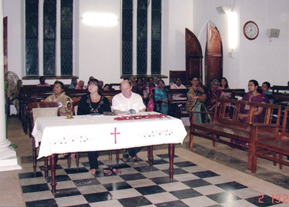
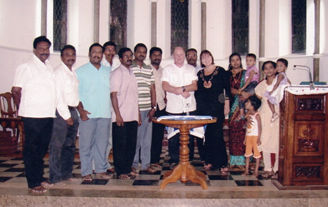
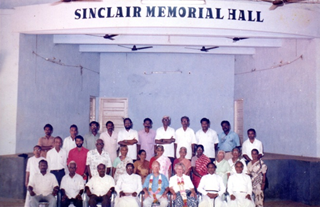
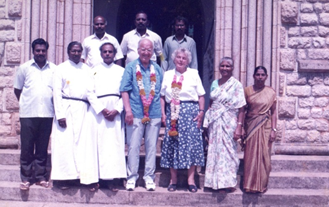
Dr. John Sinclair visited Marthandam again in the year 2011 in the month of January, deeply overjoyed to see the fully constructed Sinclair Hall, which stood as a testament to his father’s legacy. His father, Reverend Sinclair, had laid the foundation for the Marthandam Church and built it and the hall built in his name was a symbol of the enduring impact of his contributions. Dr. John Sinclair expressed immense pride and gratitude for the community’s efforts in preserving his father's vision. His visit not only honored the past but also strengthened the connection between the church’s history and its vibrant present.
I sincerely thank Mr. Ebenezer for providing me with the photographs of Dr. John Sinclair’s second visit.
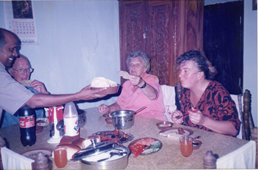 Mr. Ebenezer with Dr. John Sinclair’s family
Mr. Ebenezer with Dr. John Sinclair’s family
Conclusion
The life of Robert Sinclair exemplifies deep faith, dedication, and sacrifice, shaping the spiritual landscape of Martandam and its surrounding communities. His tireless work in building churches, schools, and fostering strong connections between Scotland and South India left an indelible mark. His son, Dr. John R. Sinclair, continued this legacy by laying the foundation stone of the memorial hall, ensuring his father’s contributions were forever honored. The Sinclair family's unwavering commitment to faith, education, and service underscores the enduring message that the true Church is not just a building, but the people it serves.

Click here for : Eye related Tamil blogs : https://tamilsuresh.com/
Click here for : Eye related English blogs : https://www.suresheyehospital.in/


